| Although I’m in the business of repairing and
restoring fountain pens, I’d be silly to ignore the fact that
some collectors are eager not only to use, but also to maintain and
even repair their pens. Replacing a leaking, ossified, or otherwise
dead sac is among the simplest and most straightforward repairs you
can make, and I know from experience that it's tremendously
satisfying to start with a pen that won't take ink and end with one
that does. This article, then, is my way of sharing that pleasure
with you.

It’s always a
good idea to learn by practice rather than waiting until a precious
pen is on the line. To this end, I suggest you buy a couple of cheap
pens on eBay or at your local flea market or antique mall to teach
yourself the ropes before you turn your attention to your minty red
ripple Waterman’s Ideal No. 7 with the Blue nib. Arnold,
Wearever, Epenco, and Tuckersharpe are some cheap names to look for,
and there are countless no-name junkers that go for less than $10.00.
(I use the term “junkers” loosely, as you already know if
you've read Don Fluckinger’s recent Extra Fine Points series on these pens.) If you get pens
that have sacs, you can easily rip ’em out. This, too, is part
of learning to resac a pen.
Tools and Supplies
First, you need a supply of sacs. No problem. Shown
here, from top to bottom, are No. 13, No.
16 (latex and silicone), and No. 22 straight
sacs. At the bottom, for reference, are a Debutante Vacumatic
diaphragm and a standard Waterman Ink-Vue sac.
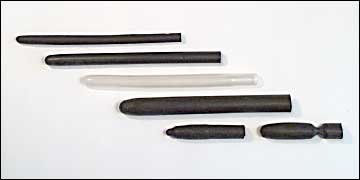
My sac vendors of choice are the Pen Sac Company and
Wood Bin Ltd. (Contact information for all the suppliers I mention is
at the end of this article.) The Pen Sac
Company sells a bewildering variety of straight sacs, necked sacs,
tapered sacs, Ink-Vue sacs, and Vacumatic diaphragms.
(“Diaphragm” is what Parker called the rubber doohickey
in a Vacumatic so they could advertise the pen as being sacless.)
They offer a couple of assortments as well as individual sacs. Their
catalog includes several pages of information showing which sacs go
into which pens. (There may be exceptions on a per-pen basis; the
catalog says to use a No. 21 necked sac for a hard-rubber Duofold
Junior, but I couldn’t even get a No. 20 to fit into the barrel
of a Junior I resacked some time ago.) Wood Bin Ltd offers a smaller
variety, but Wood Bin also sells straight sacs made of silicone.
Silicone is sometimes a better choice than latex because it
doesn’t outgas sulfur vapor that can cause some celluloids to
turn brown.

You can also buy
sacs from Fountain Pen Hospital, Pendemonium, and others; and Pen Sac
Company and Wood Bin Ltd will of course be happy to sell you one or
two sacs.

Next, you need sac
cement. Some pen suppliers can sell you sac cement; several of the
vendors I list here offer small bottles with an applicator brush for
about $5.00. Being a professional cheapskate, I ran down to my local
paint store and handed over about five bucks for a half-pint can of
orange shellac, which is what the pen companies themselves used. I
have enough shellac to last until my 273rd birthday. On the other
hand, I don’t have that nice applicator brush, so I have to
resort to subterfuge. I use toothpicks.

Steal your
spouse’s talcum powder, but make sure that it is 100% pure
talcum powder. Do not use baby powder or ladies’ dusting
powder, or any powder that contains fragrances, cornstarch, zinc
oxide, or other additives! These products are oiled to protect
delicate skin, and oil eats rubber. Pen sacs are rubber... If
there’s no plain talcum powder in the house, go buy a can. (I
should point out that pure talcum powder is very hard to find these
days; your best bet may be from a billiards supplier.) If you
absolutely cannot find talcum powder, you can substitute powdered
graphite. This stuff is sold by hordware stores and locksmiths for
lubricating locks and other mechanisms that are exposed to cold and
wet. It's messy, but it does work.

The last pen-geek
item you’ll need is section pliers. Many pens
— most, really — don’t call for
the big guns, so you may not need section pliers immediately. When
the time comes, you can buy very good ones from Fountain Pen Hospital
(shown here) or from Father Terry Koch.
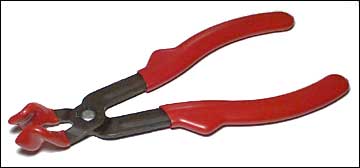
Note that the Fountain Pen Hospital pliers shown here
are actually intended by their manufacturer, K–D Tools, for use
on automobile spark plug wires. You may be able to find them for a
lower price at an auto parts store.
If you have a bench grinder, you can make your own
section pliers out of garden-variety slip-joint pliers from a
hardware store and some rubber fuel-line tubing from an auto parts
store. If you go this route, you’ll need two pieces of tubing,
each about an inch long, of a size to slip securely over one jaw of
the pliers. Grind the teeth off the concave serrated part of the
jaws, leaving a smooth curve, and slip one rubber onto each jaw.
Position them so that they cover the part of the jaws that you ground
smooth; that’s the area in which you’ll grip a
section.
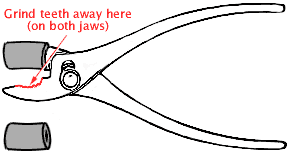
This is exactly the way Father Terry makes his section
pliers, and to be quite frank, I bought a pair from him rather than
expend the effort to make them.

Okay, you have the
tools (with one possible afterthought, of which more below). Sit
yourself down at a well-lighted table or desk, and we’re
off.
Disassembly, Cleaning, and Sac Removal
The first job is to get the old sac out. This means
taking the pen apart. Most pens have a section that is a slip
friction fit (just pushed into the barrel), but some (notably button
fillers, Touchdowns, and Snorkels) have a threaded section that
screws out. Virtually all lever fillers, except a few early
Sheaffers, are a slip fit. For simplicity, I’m going to
describe only the typical slip-fit lever filler in this article. (If
you decide you like this kind of work, get a copy of “Da
Book,” Frank Dubiel’s indispensable guide to fountain pen
repair, and let Frank show you how to handle the more esoteric pens.)

First, try using
your fingers to rock the section gently back and forth sideways,
pulling as you rock, to break it loose. Don’t rock too far or
you risk cracking the barrel!

If it refuses to budge, it’s probably shellacked
in place. (Sheaffer shellacked visulated sections but not hard rubber
ones, for example.) You can resort to section pliers. Grasp the
barrel firmly in your closed fist. (You can enhance your grip by
using a rubber kitchen jar-lid gripper.) With the other hand, apply
the section pliers to the section, and repeat the rocking/pulling
action, twisting a little as if to unscrew the section. If it’s
a slip-fitter, it’ll come loose unless it’s been
shellacked in place, or possibly even glued (as on Waterman’s
Taperite from the 1940s). In that case, you’re better off
leaving it to a professional. Yes, I know, you just blew the price of
a pen on tools. Use them on the next pen.
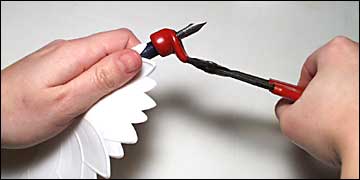
With the section loosened, you should be able to work
it gently out of the barrel. Use your fingernails or a sharp kitchen
knife to scrape all remaining fragments of the sac from the end of
the section (the nipple). You need to get the nipple as clean as
possible so the new sac will adhere properly. You can use your knife
to scrape off the shellac that is probably there, and you can use
rubbing alcohol as a solvent for this operation. But don’t use
alcohol on a visulated section; the plastic used for visulated
sections is likely to be soluble in alcohol!
  
This is your opportunity to do your pen a favor by
giving it a thorough cleaning. Drop the section assembly into a bath
of diluted clear household ammonia for five or ten minutes. Make your
solution by mixing 1 tablespoon (15 cc) of ammonia with
2/3 cup (160 cc) of water. After soaking
the parts, scrupulously clean off any ink residue and the cleaning
solution. This means flushing water through the system, which you can
do by using an ear syringe to force water through the section from
the sac end. (If you don’t have an ear syringe, you can use
your mouth for this job.) When the assembly is clean, dry it
thoroughly; blow some air through to dry the inside.

Clean the cap the
same way, paying particular attention to getting the ink out from
inside the cap. One way to do this is to use a paper napkin. Twist
one corner of the napkin into a long thin spear, and insert it into
the cap with a screwing motion. Turn in the direction that will keep
the twist tight. Drive the paper as far down as you can get it.
Repeat as necessary.

Now, if the sac
didn’t come out in one piece, extract its remains from the
barrel. A long thin alligator pliers, such as you can get from Wood
Bin Ltd, Fountain Pen Hospital, or Widget Supply, can be helpful here
but isn’t a necessity. If the sac is ossified, you can probably
just dump out the chips. Occasionally you’ll run into a sac
that has managed to glue itself, whole or in pieces, to the inside of
the barrel. This can get ugly. I use various
“afterthought” tools such as dental picks and scalers to
chisel pieces of sac away from barrel walls. You can get dental picks
from Wood Bin Ltd or Widget Supply. I find scalers very useful, and I
get them from KV Vet Supply. Take your time; as with the nipple, you
want to get the barrel clean. Be careful not to damage the filler
assembly.
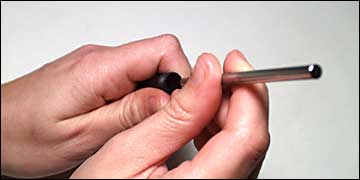
If the old sac died and dumped ink all over the inside
of the pen, clean the barrel, too. You may also find that using your
soaking solution on a barrel will make it easier to extract glued-in
bits of sac. Get the barrel absolutely dry afterward; any moisture
left inside can corrode the parts of the filling assembly.
Sac Selection and Installation
With everything clean, you’re finally ready to
install a new sac. If you don’t know the right size, try
different sizes (you bought the assortment, right?) until you find a
sac that just slips snugly into the barrel with the filler assembly
in place. Then choose a sac two numbers smaller; if a No. 18 fits
snugly, use a No. 16. You need to leave air space between the sac and
the barrel to keep the pen from transferring your body heat into the
sac when the pen is in your pocket. If the sac gets warm, the air in
it expands, and it can force ink out through the feed. This makes the
inside of the cap very messy, which is why you just cleaned it. No
matter what sac size you end up with, it needs to be a stretch fit
over the nipple. If you’ve chosen too small a sac, you may have
to go up one size. You can try stretching the end of the sac over the
nipple to verify that it’ll go.

The sac needs to be
the right length. Most sacs are “straight” sacs; that is,
the diameter of the sac is the same along its entire length. Sacs are
made much too long; you will need to cut your new sac to the right
length. To find how long it should be, slide it into the barrel,
closed end first, until it hits bottom. Slide it back out about
1/8” (3 mm) so that it won’t butt against the end of the
space into which it fits. Clamp it with your thumbnail right where it
enters the barrel, and pull it out.

Still clamping it, hold it up to the section, lining
your thumbnail up with the step on the section that seats against the
end of the barrel. Now mark the point on the sac that corresponds to
the step between the nipple and the part of the section that fits
into the barrel. This distance will be between 1/4” (6 mm) and
1/2” (13 mm). In the illustration here, you can see a bright
line where light is reflecting off the step between the nipple and
the rest of the section.
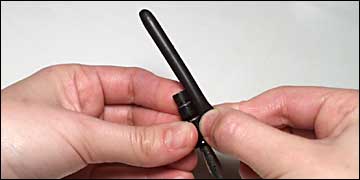
Cut the sac at this point, being careful to cut
straight across.
If your pen requires a necked sac (with the open end
smaller than the diameter of the rest of the sac, like the neck of a
bottle), you must rely on the information in the Pen Sac catalog or
else measure the space into which the sac fits and then choose a sac
of the proper length. You don’t cut necked sacs; they have to
fit right. This may mean that you can’t order the exact sac you
need until you’ve taken the pen apart.

With the sac ready
to install, apply a small amount of sac cement (shellac) around the
outside of the nipple. Be careful not to let the cement get into the
inside; it’ll clog the feed — possibly
permanently! Spread the open end of the sac, stretch it over the
nipple, and adjust it so that it’s pushed all the way down and
is seated against the step. If you find that you’re a little
clumsy and have trouble fitting the sac in place, you can buy a sac
spreader. Pendemonium offers these little gems for $5.00. I recommend
that you buy yours yesterday, as today — with wet
cement drying on your pen — isn’t the best
time to go shopping. The sac should stand straight up, in line with
the section, and the stretched part should be symmetrical on all
sides. (The sac shouldn’t be pulled over toward one side of the
nipple.) If you like, you can run a very small bead of cement around
for an improved seal right where the sac butts against the step.
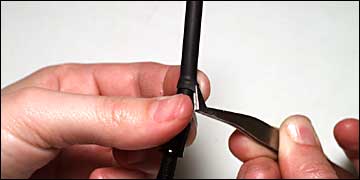
Once the sac is installed properly, put the assembly
down. Go away for half an hour to let the cement dry. It
doesn’t necessarily take half an hour, but if you adhere to a
firm half-hour waiting period, you’ll never proceed too soon.
Getting itchy and proceeding too soon means having a still-wet sac
come off in your hands or leak in the pen or —
worst of all — glue itself inside the barrel.
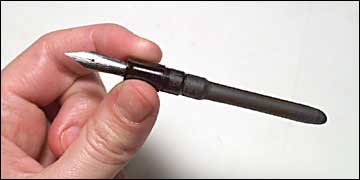
Now cover the new sac with a thin coat of talcum
powder (or graphite). This will make it slide into the barrel more
easily, and the filler will also work a little more smoothly.
Reinstall the section into the barrel, aligning the lever with the
nib as you go. (Some pens, mostly English brands such as Conway
Stewart, usually have their levers aligned on the underside, 180°
away from the nib surface.) There’s no need to cement a hard
rubber or ordinary plastic section in place unless it’s close
to falling out, but Sheaffer has always recommended that visulated
sections be shellacked in. If your section is so loose that it really
does fall out, try shimming it with a bit of paper.

Et le
voilà! You’ve just accomplished a task that used to
require the services of a highly paid professional. You’re on
the road to restoring your way to a better pen collection. Fill your
revitalized pen and enjoy the ride!
Resources
Fountain Pen Hospital
10 Warren Street
New York, NY 10007-2218
USA
Phone: 212-964-0580
Toll-free: 1-800-253-PENS
Fax: 212-227-5916
Web site: http://www.fountainpenhospital.com/
Email: fountainpenhospital@att.net
Pendemonium
Phone: 319-372-0881
Fax: 319-372-0882
Web site: http://www.pendemonium.com/
Email: info@pendemonium.com
Father Terry Koch died in May 2004, and his tools are
now available from Victor Chen.
Email: vwchen@pacbell.net
The Pen Sac Company
P. O. Box 4470
Carlsbad, CA 92018-4470
USA
Phone: 619-729-6894
Toll-free: 1-888-PENSACS
Fax: 619-931-5845
Web site: http://www.pensacs.com/
Email: PenSacs@aol.com
Wood Bin Ltd.
R.R. # 6, Simcoe
Ontario
Canada N3Y 4K5
Phone: 519-428-2555
Fax: 519-428-6311
Web site: http://www.simcom.on.ca/woodbin/
Email: woodbin@simcom.on.ca
Widget Supply
P. O. Box 3282
Albany, OR 97321-0710
USA
Fax/Voicemail: -541-924-8882
Web site: http://www.widgetsupply.com/
Email: widget@proaxis.com
KV Vet Supply
3190 N Rd
David City, NE 68632-5142
Phone: 800-423-8211
International: 402-367-6047
Fax: 800-269-0093
International: 402-367-6214
Web site: http://www.kvvet.com/
Email: kvvet@kvvet.com
The information in this article is as accurate as
possible, but you should not take it as absolutely authoritative.
© 2003, 2004 Richard F. Binder
|